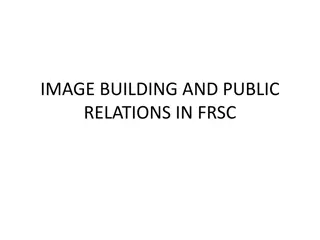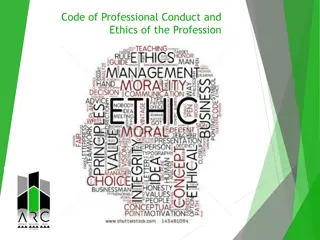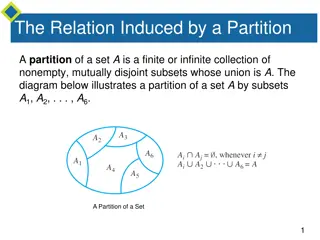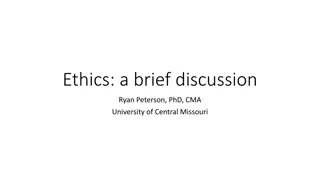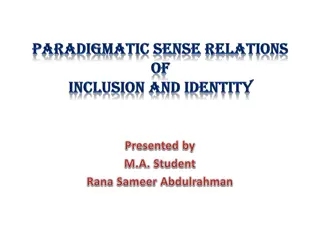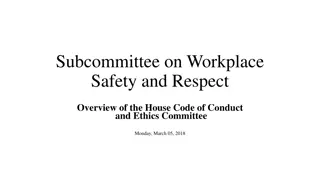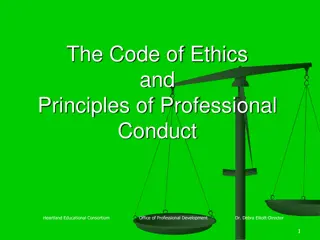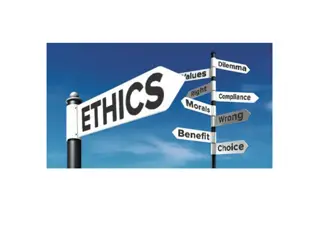Ethics in Public Relations: Standards of Conduct and Professional Principles
Ethics in public relations encompass standards of conduct based on moral duties and virtues. The field involves systematizing concepts of right and wrong behavior, emphasizing the importance of ethical practices for credibility and trustworthiness in PR. Despite criticisms, ethical issues in PR, including maintaining truthfulness, avoiding biases, and promoting transparency, are essential for upholding integrity in the profession. The ethics of PR practitioners, defined by accuracy, truthfulness, confidentiality, and avoiding conflicts of interest, are crucial for protecting the interests of clients and maintaining a professional reputation.
Download Presentation

Please find below an Image/Link to download the presentation.
The content on the website is provided AS IS for your information and personal use only. It may not be sold, licensed, or shared on other websites without obtaining consent from the author.If you encounter any issues during the download, it is possible that the publisher has removed the file from their server.
You are allowed to download the files provided on this website for personal or commercial use, subject to the condition that they are used lawfully. All files are the property of their respective owners.
The content on the website is provided AS IS for your information and personal use only. It may not be sold, licensed, or shared on other websites without obtaining consent from the author.
E N D
Presentation Transcript
Mergers &Acquisitions Priyanka Darshana
Ways to Grow ORGANIC INORGANIC
What are Mergers & Acquisitions (M&A) M&A refer to transactions between two companies combining in some form. Although M&A are used interchangeably, they come with different legal meanings. In a merger, two companies of similar size combine to form a new single entity. On the other hand, an acquisition is when a larger company acquires a smaller company, thereby absorbing the business of the smaller company. M&A deals can be friendly or hostile, depending on the approval of the target company s board.
Types of M&A Transactions 1. Horizontal A horizontal merger happens between two companies that operate in similar industries that may or may not be direct competitors. 2. Vertical A vertical merger takes place between a company and its supplier or a customer along its supply chain. The company aims to move up or down along its supply chain, thus consolidating its position in the industry. 3. Conglomerate This type of transaction is usually done for diversification reasons and is between companies in unrelated industries.
Forms of Acquisition 1. Share purchase In a stock purchase, the acquirer purchases shares of the target company. There are certain aspects to be considered in a stock purchase: The acquirer absorbs all the assets and liabilities of the target even those that are not disclosed. The target s shareholders must approve the transaction through a majority vote, which can be a long process.
Forms of Acquisition 2. Asset purchase In an asset purchase, the acquirer purchases the target s assets and pays the target directly. There are certain aspects to be considered in an asset purchase, such as: Since the acquirer purchases only the assets, it will avoid assuming any of the target s liabilities. As the payment is made directly to the target, generally, no shareholder approval is required.
Mergers and Acquisitions (M&A) Valuation In an M&A transaction, the valuation process is conducted by the acquirer, as well as the target. The acquirer will want to purchase the target at the lowest price, while the target will want the highest price. Thus, valuation is an important part of M&A, as it guides the buyer and seller to reach the final transaction price (purchase consideration).
Valuation Methods Below are three major that are used to value the target: 1. Discounted cash flow (DCF) method: The target s value is calculated based on its future cash flows. 2. Comparable company analysis: Relative valuation metrics for public companies are used to determine the value of the target. 3. Comparable transaction analysis: Valuation metrics for past comparable transactions in the industry are used to determine the value of the target.
Companies spend morethan $2 trillion on acquisitions every year. Yet study after study puts the failure rate of mergers and acquisitions somewhere between 70% and 90% Source: Harvard Business Review
Common Pitfalls of Acquisition 1. Wrong Target Almost nobody understands how to identify targets that could transform a company, how much to pay for them, and how to integrate them. Case : eBay, the online auction giant, bought Skype, the VOIP/IM newcomer with around 57MM registered users at the time, for $2.6BN in 2005. How did the deal fair ?
Common Pitfalls of Acquisition 2. Poor Synergy Many M&As fail to live up to their hoped benefits because managers have given inadequate thought to how a new business will be related to their firm s existing business Case : Hewlett consultancy arm for $18 billion in a bid to boost HP's technology advisory services. Incredibly, two years later, HP rival IBM scooped consultancy unit for just $3.5 billion Packard acquired PwC's up the
Common Pitfalls of Acquisition 3. Failure on Due Diligence Failing at due diligence often means failing at M&A. ... Yet, it is often the neglected stepchild of due diligence in M&A deals can expose parties to risks that lower the value of the deal. Case : BMW Rover BMW did not do enough due diligence, completing a deal in only 10 days. That is to say, they did not look closely enough at the operation of the businesses within Rover. Had they done so, they may have had a much better view of Rover s problems such as inaccurate sales data, culture not invented here etc.
Common Pitfalls of Acquisition 4. Culture Crashes After all it s the culture on top of all that matters Case : When German Daimler (the makers of Mercedes- Benz) merged with American company Chrysler in the late 1990s, it was called a merger of equals . later was being called a fiasco . Differences between the companies, philosophy on pay and expenses, and operating styles. The German culture became dominant and employee satisfaction levels at Chrysler dropped off the map. The deal worth $ 37Bn collapsed in 2007, Daimler disposing Capital Management for $6 billion. level of formality, Chrysler to Cerberus



